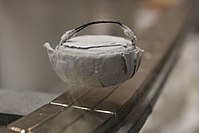
Photo from wikipedia
In d$_{x^2-y^2}$-wave superconductors, the effect of s-wave point disorder has been extensively studied in the literature. In this work, we study the anisotropic disorder with a the form of $V_{kk'}^{\rm… Click to show full abstract
In d$_{x^2-y^2}$-wave superconductors, the effect of s-wave point disorder has been extensively studied in the literature. In this work, we study the anisotropic disorder with a the form of $V_{kk'}^{\rm imp}=V_if_kf_{k'}$ with $f_k=\cos(2\theta)$ (with $\theta$ the azimuthal angle of $k$), as proposed to be caused by apical oxygen vacancies in overdoped La-based cuprate films, under the Born approximation. The disorder self-energy and d-wave pairing affect each other and have to be solved simultaneously self-consistently. We find the self-energy is reduced at low frequencies and thus weakens the pair-breaking effect. This frequency-dependence vanishes in the dirty limit for which the disorder is well described by a scattering rate $\Gamma_k=\Gamma_if_k^2$. One consequence of the disorder effect is the gap-to-$T_c$ ratio $2\Delta(0)/T_c$ is greatly enhanced by the d-wave disorder, much larger than the s-wave disorder and the clean BCS value $4.28$. At last, we generalize the d-wave scattering rate to a general form $\Gamma_\theta=\Gamma_\alpha|\theta-\theta_0|^\alpha$ around each nodal direction $\theta_0$. We find the density of states $\rho(w)-\rho(0)\propto|w|$ ($w^2$) for all $\alpha\ge1$ ($\alpha<1$) in the limit of $w\to0$. As a result, the superfluid density $\rho_s$ exhibits two and only two possible scaling behaviors: $\rho_s(0)-\rho_s(T)\propto T$ ($T^2$) for $\alpha\ge1$ ($\alpha<1$) in the low temperature limit.
Journal Title: Chinese Physics Letters
Year Published: 2023
Link to full text (if available)
Share on Social Media: Sign Up to like & get
recommendations!